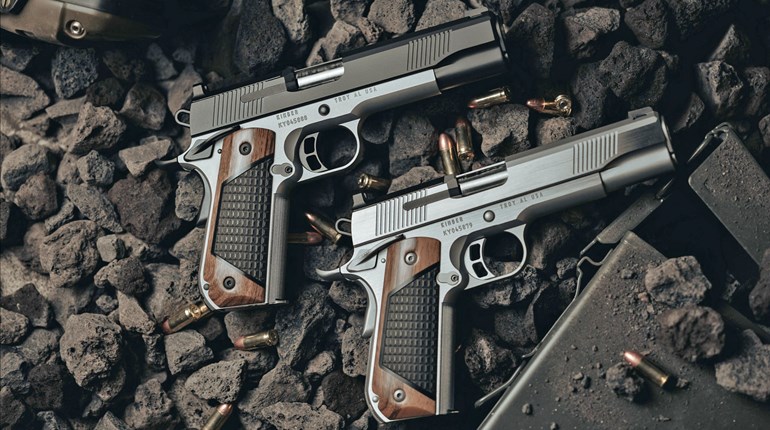
I pushed the button and the elevator door opened. Suddenly, there were two armed bad guys running toward me at full speed. I panicked as I drew my pistol and started blasting. Forgetting the basics of trigger pull and sight alignment, I resorted to "spray and pray" even though I knew better. I got lucky and took one of them out, but the other didn't have a mark on him, which was a big problem. Or at least it would have been if this had been real life. The first stage of my first IDPA match didn't go so well, but that's why I was there—to learn from my mistakes.
If you carry a handgun for self-defense, it is crucial to practice and train regularly. Anytime you pick up a gun, you input information into your brain's data bank that could be of use later. However, the simple fact is that nothing can completely prepare you for a fight for your life.
Range time and dry-fire practice certainly help, as long as you take it seriously and conduct proper drills. Training courses taught by knowledgeable instructors are also beneficial, but you must continue to practice what you have learned.

The closest we can come to a real-world fight is by inducing stress through competition. Any discipline will help; even bullseye pistol will train you to focus on sight alignment and trigger control against pressure brought on by the clock. Obviously, though, competition that closely recreates real gunfight scenarios offers the most benefit.
The United States Practical Shooting Association (USPSA) was created with that goal in mind. Over the years, however, some shooters came to believe the organization lost its way by becoming too focused on the competitive aspect and by opening the door for unrealistic race guns and other equipment. Debating that is for another time, except to say the competitive focus made it a very expensive game that was difficult for casual shooters to play. (USPSA later recognized that shortcoming and added a Production division limited to factory guns to help recruit new shooters.)

In 1996 a few competitors, including Bill Wilson, Ken Hackathorn, John Sayle and Larry Vickers, decided to start a new competitive discipline more true to the concept of self-defense. They called the resulting organization the International Defensive Pistol Association (IDPA).
Robert Ray, IDPA membership and advertising director and editor of the association's Tactical Journal, says the organization was designed for the beginning or average shooter. Match personnel are encouraged to help new shooters through that often-intimidating first competition.
My first IDPA match was a big one, the Indoor Championships at the Smith & Wesson Shooting Sports Center in Springfield, MA. Might as well start at the top.
I always seem to screw up the first stage of any competition, and this was no exception. Even though I calmed down and started shooting better, I didn't win my division, but I did win top media shooter—which is like out-bowling the President. I didn't dare look to see how many other writers were shooting!

For a new shooter in any discipline, that all-important first match can be a bit scary. You don't know the lingo, you don't really understand the way it all works, and it appears like every other shooter is an old pro. IDPA strives to make sure you have some help through all that. After your first match, you will be hooked—I promise. After a few more, you will be the old pro, proudly showing newbies the ropes.
IDPA tries to keep the price of getting started reasonable. The idea is a shooter can start with a gun right out of the box—no custom work needed. You don't need to spend thousands of dollars on the newest gadgets, fancy holsters or optical sights. Instead, you can compete with your carry gun.
There are five categories for handguns and equipment, so you compete against shooters using the same type of guns and ammunition. I can all but guarantee there is a division permitting you to shoot with any defensive handgun you currently own, as long as it's chambered in 9 mm or larger.

IDPA also ranks you by your skill level, so you compete against others with similar ability. That means everybody has a chance to win, even at their very first match. It also means top shooters still have some serious competition. In this way, IDPA is a sport for every level, from beginners to the best shooters in the world. I know, I shot with some of them in my first IDPA match. Being in the same group with top-ranked shooters is a great learning experience. Not only can you watch them shoot, but most are friendly and willing to help coach novices.
Competing in an IDPA match puts you in contact with a lot of people who can help with training. Everyone there is a shooter, and they all know other people who are shooters. This is the perfect networking facility to find anything you need, from more affordable ammo to info on the top shooting schools.
IDPA rules (there are a lot of them) are designed to make sure the guns and holsters are realistic for carry. The guns must be concealed with a garment, which makes you access your pistol and draw it the same way you would on the street. Stages usually require you to shoot from cover. Reloads are also from cover, and you cannot drop any magazine that still contains ammo. These are all well-thought-out rules that may save your life in the real world.
Shooting IDPA lets you use your personal-protection handgun in several different real-life situations. It makes you shoot while the clock is running and others are watching, both of which induce stress.

While that might seem like a bad thing, it is not. If you have to shoot to save your life, you will be experiencing a great deal of stress. Nothing short of actual combat can simulate that pressure exactly, but competitive shooting comes close. Your mind and body learn how to deal with that stress, which might carry over and help keep you alive in a real situation. You also build familiarity with your firearms and accessories, a necessity when you have to fight for your life.
Some contentious types claim this is not training. They argue there is no timer in real life, and that induces an element of distraction. They say since IDPA is a game, it introduces ingredients that skew the situation from what happens in the real world.
Perhaps that's true. Defensive-pistol training courses might be more realistic. But after the three-day course is over, then what? You need to practice the skills you learned. IDPA competition is a great way to do so and keep your skills sharp.
The match directors and course designers for IDPA matches are encouraged to build each stage as a realistic, fight-for-your-life scenario. In fact, Ray told me IDPA stage designers often use reports from the "Armed Citizen" column in American Rifleman as inspiration for setting up the courses-of-fire.
Expect plenty of "no-shoot" targets as well as bad guys hiding behind cover or hostages. Every stage is different and you never know what to expect—just like in real life.
Most lifesaving shootouts require only one or two rounds, and some stages are that simple. Of course, this is a shooting game and a competition more than anything else, so a typical stage is a bit longer, but they never require more than 18 rounds. This appeals to a lot of today's shooters, as the resulting low-round count for the match is a blessing with today's ammo shortages and high prices.
One other thing: IDPA is a shooting competition, not an athletic event. While you will be required to move, there will not be a lot of running, jumping and climbing as in some other shooting competitions.
The association currently has 16,000 members, including 1,600 foreign members. An astounding 83 percent of members have carry permits, which is amazing when you consider the states that won't issue permits or foreign members living in countries where no such permits exist. It is a fast-growing sport; two out of the first three months of 2010 have broken records for new IDPA members, and the third month fell short of breaking the record by only 11 members.
IDPA is a safe, challenging sport designed for concealed-carry permit holders. Its nature appeals to the multitudes of new gun owners who have accepted responsibility for personal protection by purchasing a gun. If you carry a handgun for self-defense, or if you just love to pull a trigger, perhaps it's time you checked out IDPA.
Gear Up Practically
The gun I carry most often is a 1911 in .45 ACP. If IDPA is about using your carry gun, then it stands to reason I would shoot the same.
The 1911 with which I am most in love at the moment is the Smith & Wesson Performance Center SW1911. Being a left-handed shooter, one big reason I chose the pistol was its ambidextrous thumb safety. I also like the flared magazine well, serrations on the front and rear of the slide and the fact it has one of the best triggers I have encountered on any pistol.
The gun came with adjustable sights. However, I replaced the black post in front with a fiber-optic sight. After the low-light Indoor Championships match, that sight was destined to be swapped for one from XS Sight Systems containing tritium. Shooting IDPA identified a real problem with my carry gun: I could not see the sights, even the fiber-optic sights, in low light. Who knows, finding and fixing that problem might save my life one day.
I love good leather, but I have come to realize Kydex makes a lot of sense for both concealed carry and IDPA competition. My Kydex holster and magazine holders are from Comp-Tac. The leather belt I had been using was too limber, so I ordered the company's Kydex-reinforced belt. It turned out to be so comfortable, I use it for everyday concealed carry.
With a few boxes of Federal American Eagle 230-grain FMJ, I'm ready to shoot. IDPA is pretty low-maintenance competition. In addition to eye and ear protection, all you need is a gun, a few spare magazines, a holster and some mag pouches. I bet you already have the limited equipment it takes to get started.






































